CHEVROLET CAVALIER 1996 3.G Owners Manual
Manufacturer: CHEVROLET, Model Year: 1996, Model line: CAVALIER, Model: CHEVROLET CAVALIER 1996 3.GPages: 372, PDF Size: 19.73 MB
Page 211 of 372
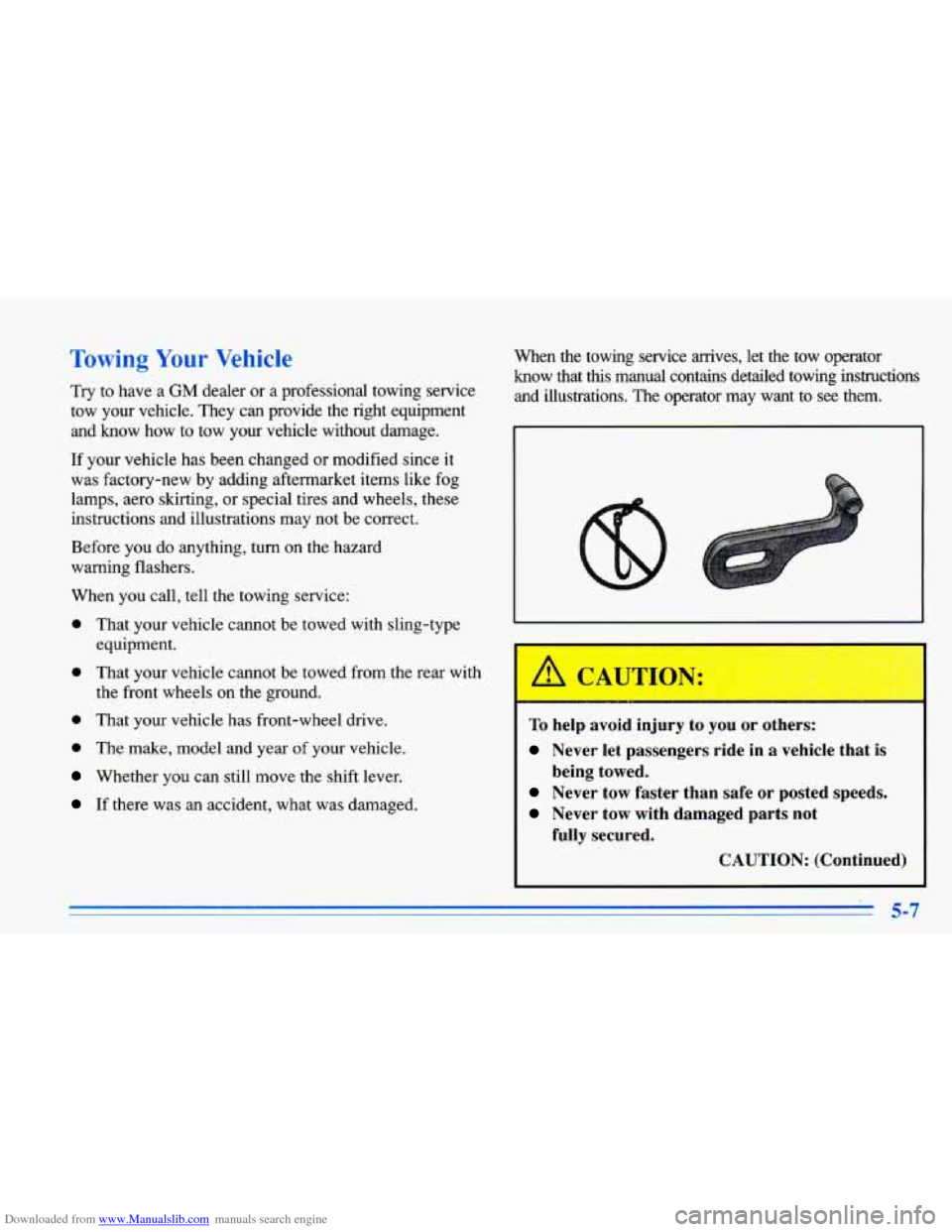
Downloaded from www.Manualslib.com manuals search engine Towing Your Vehicle
Try to have a GM dealer or a professional towing service
tow your vehicle. They can provide the right equipment
and know how to tow your vehicle without damage.
If your vehicle has been changed or modified since it
was factory-new by adding aftermarket items like fog
lamps, aero skirting, or special tires and wheels, these instructions and illustrations may not be correct.
Before you do anything, turn on the hazard
warning flashers.
When you call, tell the towing service:
0 That your vehicle cannot be towed with sling-type
0 That your vehicle cannot be towed from the rear with
0 That your vehicle has front-wheel drive. equipment.
the front wheels on the ground.
0 The
make, model and year of your vehicle.
Whether you can still move the shift lever.
If there was an accident, what was damaged. When the towing service arrives, let the tow operator
know that this manual contains detailed towing instructions
and illustrations. The operator may want to see them.
To help avoid injury to you or others:
Never let passengers ride in a vehicle that is
Never tow faster than safe or posted speeds.
Never tow with damaged parts not being towed.
fully secured.
CAUTION: (Continued)
Page 212 of 372
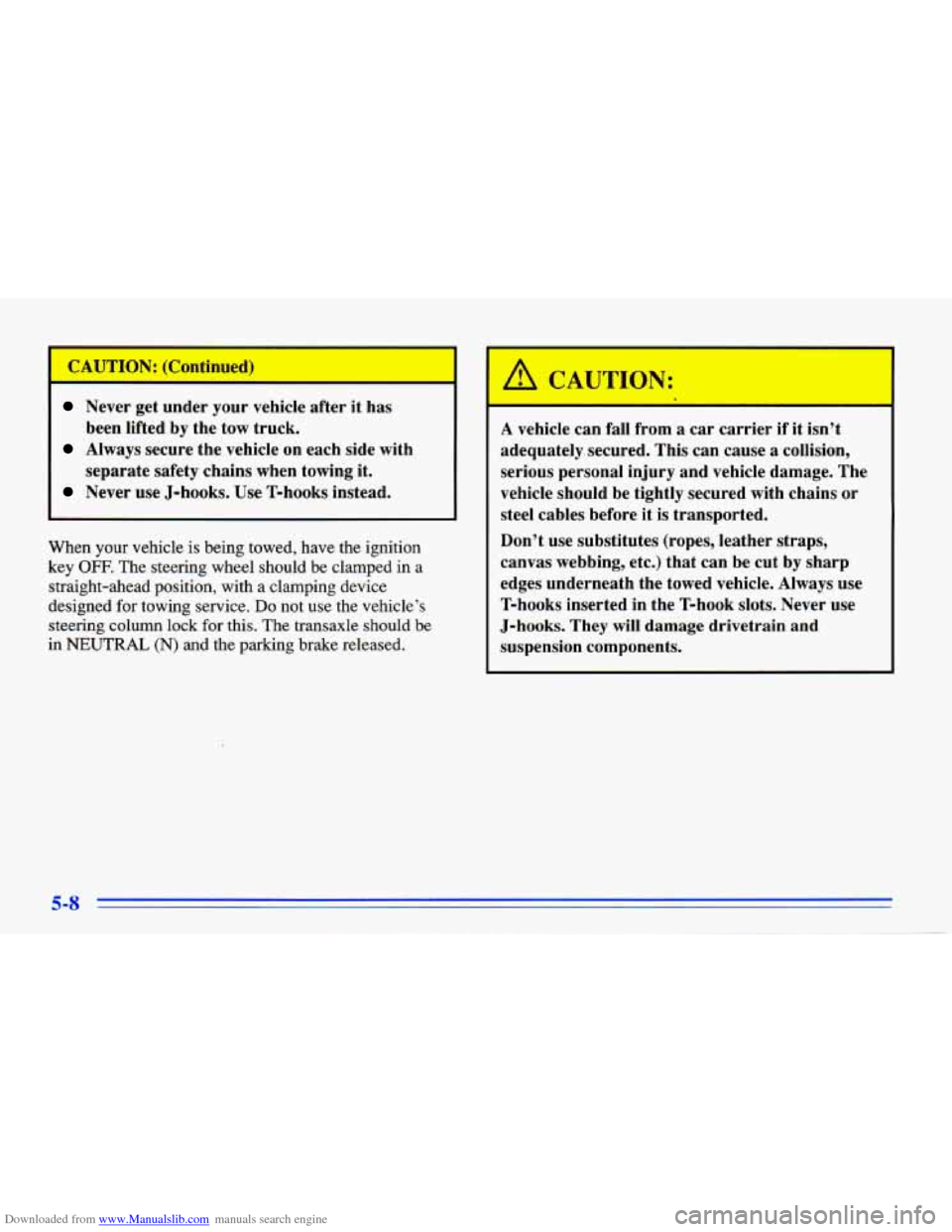
Downloaded from www.Manualslib.com manuals search engine -- IO Iontinut I I
Never get under your vehicle after it has
been lifted by the tow truck.
Always secure the vehicle on each side with
separate safety chains when towing it.
Never use J-hooks. Use T-hooks instead.
When
your vehicle is being towed, have the ignition
key OFF. The steering wheel should be clamped in a
straight-ahead position, with a clamping device
designed
for towing service. Do not use the vehicle’s
steering column lock for this. The transaxle should be
in
NEUTRAL (N) and the parking brake released.
A CAUTION:
I
A vehicle can fall from a car carrier if it isn’t
adequately secured. This can cause
a collision,
serious personal injury and vehicle damage. The
vehicle should be tightly secured with chains or
steel cables before it is transported.
Don’t
use substitutes (ropes, leather straps,
canvas webbing, etc.) that can be cut by sharp
edges underneath the towed vehicle. Always use
T-hooks inserted in the T-hook slots. Never use
J-hooks. They will damage drivetrain and
suspension components.
5-8
Page 213 of 372

Downloaded from www.Manualslib.com manuals search engine Front Towing
Before hooking up to a tow truck, be sure to read all
the information in “Towing Your Vehicle” earlier in
this section. Attach T-hook
chains into the
slots in the bottom of the
floor pan, just behind the front wheels, on both
sides.
These slots are to be used when loading and securing to
car carrier equipment.
5-9
Page 214 of 372
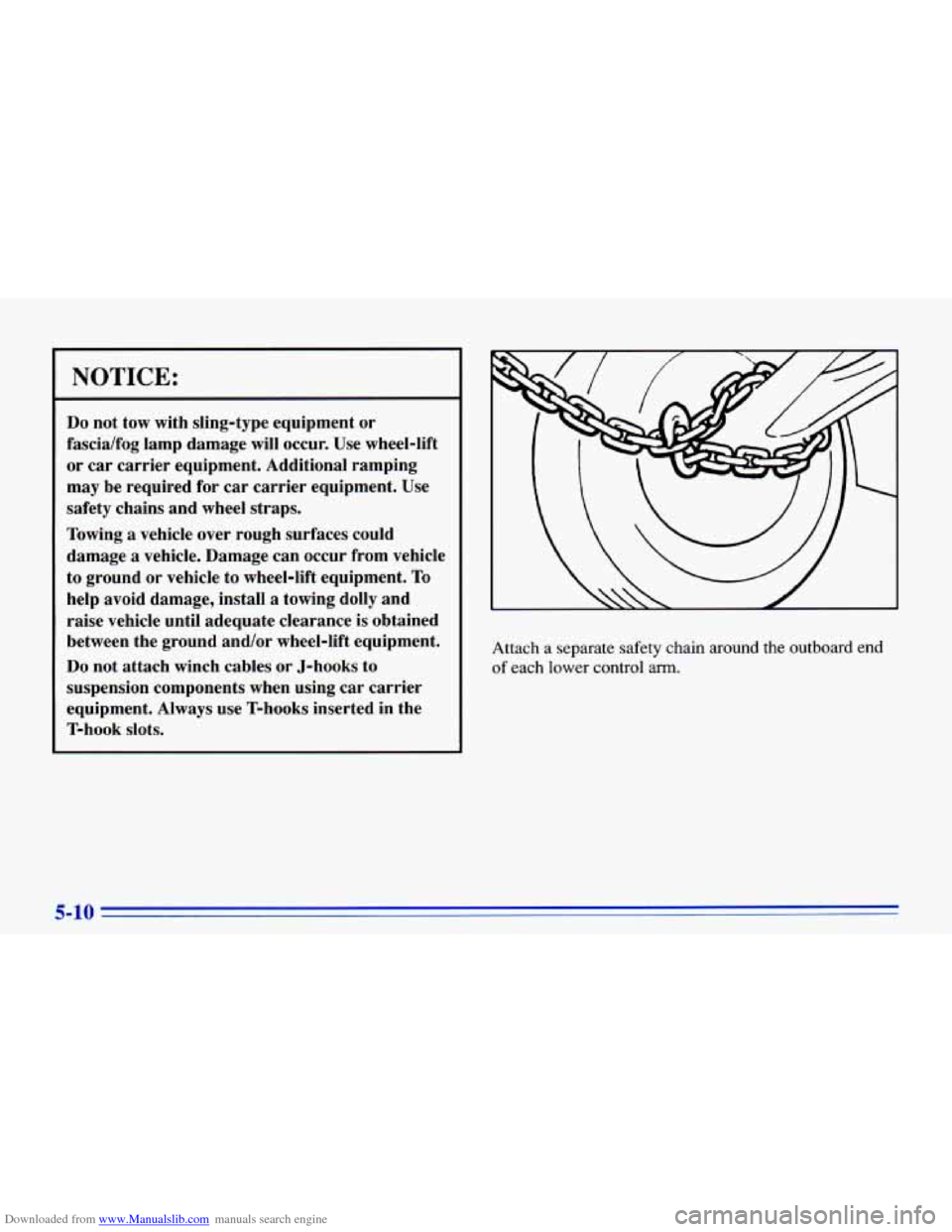
Downloaded from www.Manualslib.com manuals search engine NOTICE:
Do not tow with sling-type equipment or
fascia/fog lamp damage will occur. Use wheel-lift
or car carrier equipment. Additional ramping
may be required for car carrier equipment. Use
safety chains and wheel straps.
Towing
a vehicle over rough surfaces could
damage
a vehicle. Damage can occur from vehicle
to ground or vehicle to wheel-lift equipment. To
help avoid damage, install a towing dolly and
raise vehicle until adequate clearance
is obtained
between the ground and/or wheel-lift equipment.
Do not attach winch cables or J-hooks to
suspension components when using car carrier
equipment. Always use T-hooks inserted in the
T-hook slots. Attach a separate safety chain around
the outboard
end
of each lower control arm.
5-10
Page 215 of 372
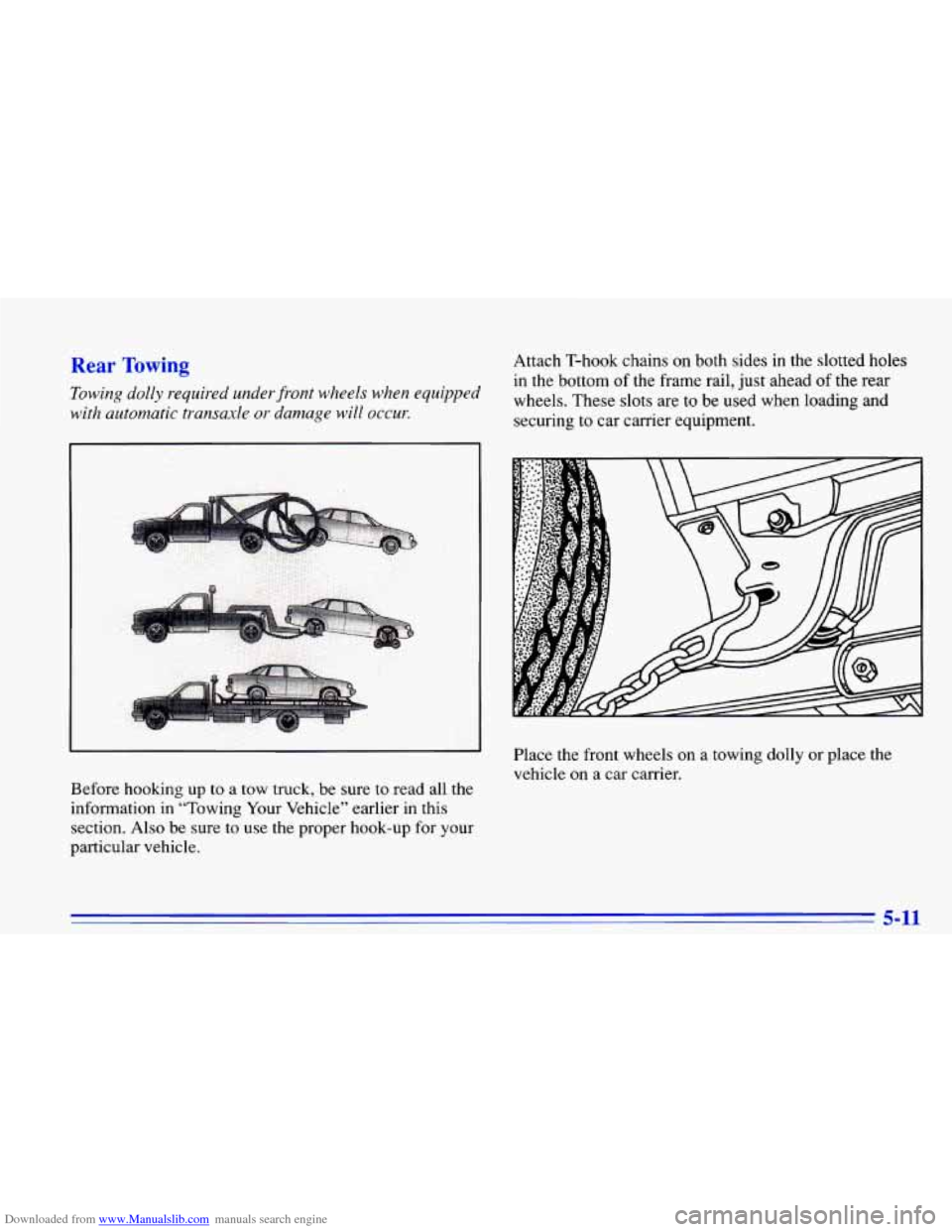
Downloaded from www.Manualslib.com manuals search engine Rear Towing
Towing dolly required underfiont wheels when equipped
with automatic transaxle
or damage will occur.
Attach T-hook chains on both sides in the slotted holes
in the bottom of the frame rail, just ahead of the rear
wheels. These slots are to be used when loading and
securing to car carrier equipment.
Before hooking up
to a tow truck, be sure to read all the
information in “Towing Your Vehicle” earlier in this
section,
Also be sure to use the proper hook-up for your
particular vehicle. Place
the front wheels on
a towing dolly or place the
vehicle on a car carrier.
5-11
Page 216 of 372
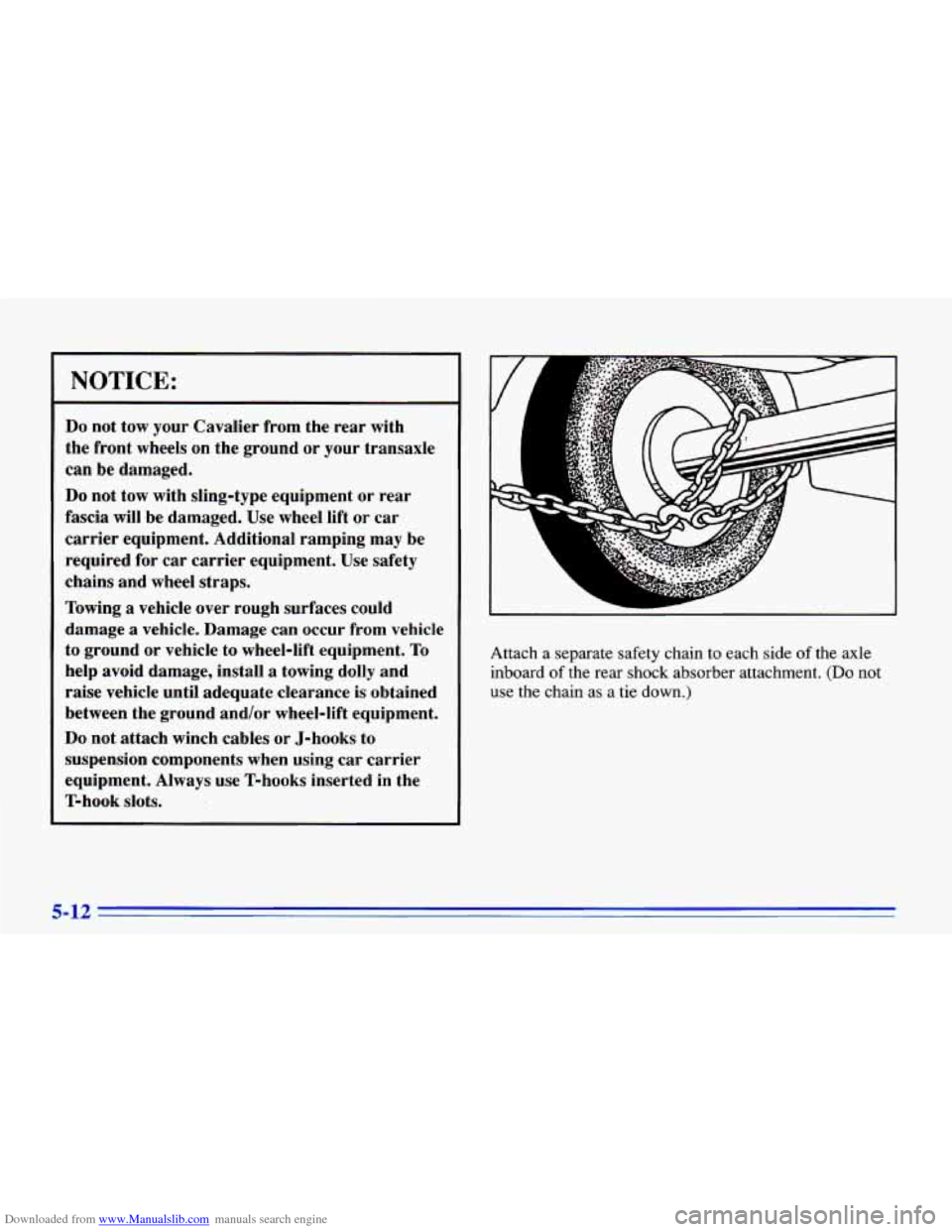
Downloaded from www.Manualslib.com manuals search engine NOTICE:
Do not tow your Cavalier from the rear with
the front wheels on the ground or your transaxle
can be damaged.
Do not tow with sling-type equipment or rear
fascia will be damaged.
Use wheel lift or car
carrier equipment. Additional ramping may be
required for
car carrier equipment. Use safety
chains and wheel straps.
Towing
a vehicle over rough surfaces could
damage
a vehicle. Damage can occur from vehicle
to ground or vehicle to wheel-lift equipment. To
help avoid damage, install
a towing dolly and
raise vehicle until adequate clearance is obtained
between the ground and/or wheel-lift equipment.
Do not attach winch cables or J-hooks to
suspension components when using car carrier
equipment. Always use T-hooks inserted in the
T-hook slots.
A
I I
Attach a separate safety chain to each side of the axle
inboard of the rear shock absorber attachment.
(Do not
use the chain as a
tie down.)
5-12
Page 217 of 372
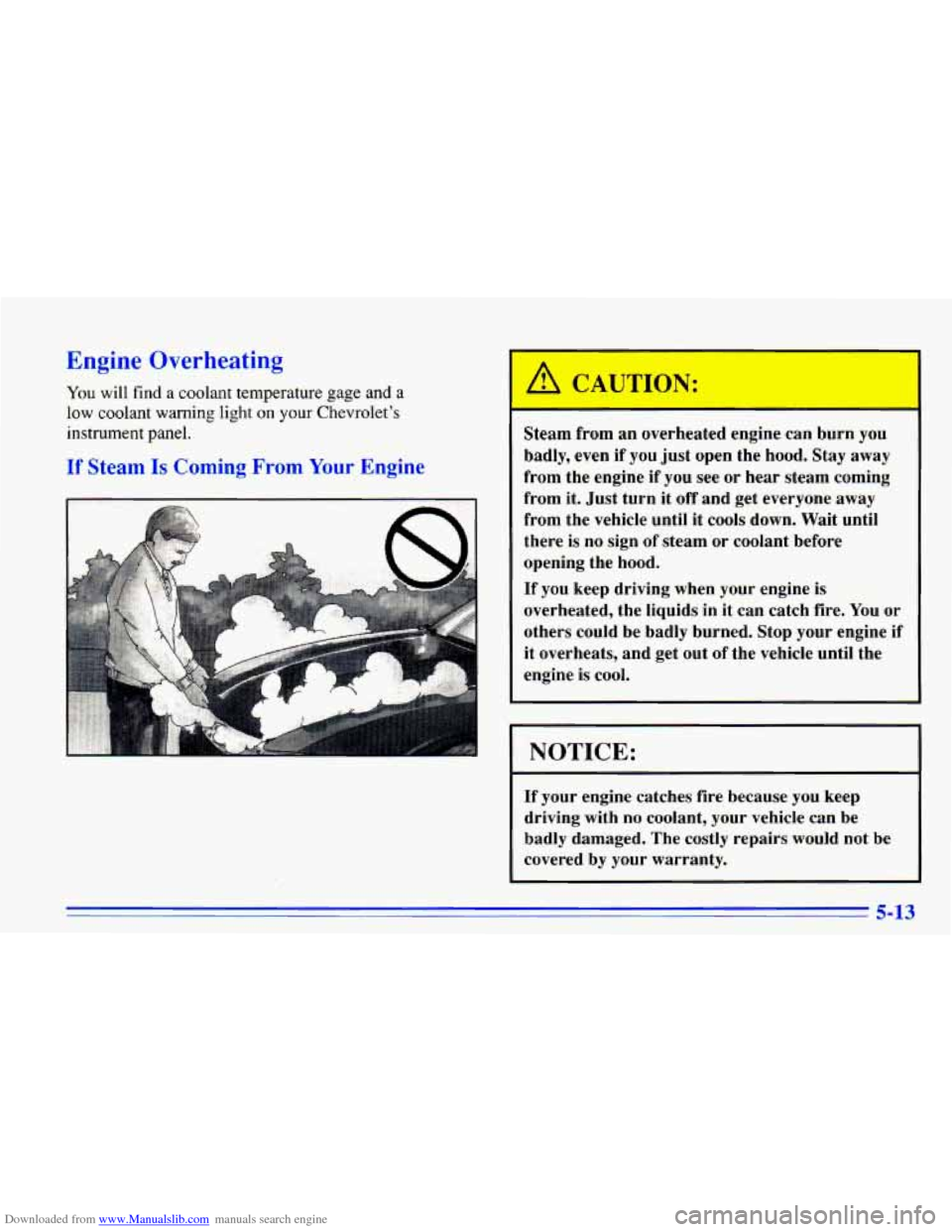
Downloaded from www.Manualslib.com manuals search engine Engine Overheating
You will find a coolant temperature gage and a
low coolant warning light on your Chevrolet’s
instrument panel. Steam
from an overheated engine can burn you
badly, even if you just open the hood. Stay away
from the engine if you
see or hear steam coming
from it. Just turn it
off and get everyone away
from the vehicle until it cools down. Wait until
there is no sign of steam or coolant before
opening the hood.
If you keep driving when your engine
is
overheated, the liquids in it can catch fire. You or
others could be badly burned. Stop your engine
if
it overheats, and get out of the vehicle until the
engine is cool.
I NOTICE:
If your engine catches fire because you keep
driving with no coolant, your vehicle can be
badly damaged. The costly repairs would not be
covered by your warranty.
5-13
Page 218 of 372
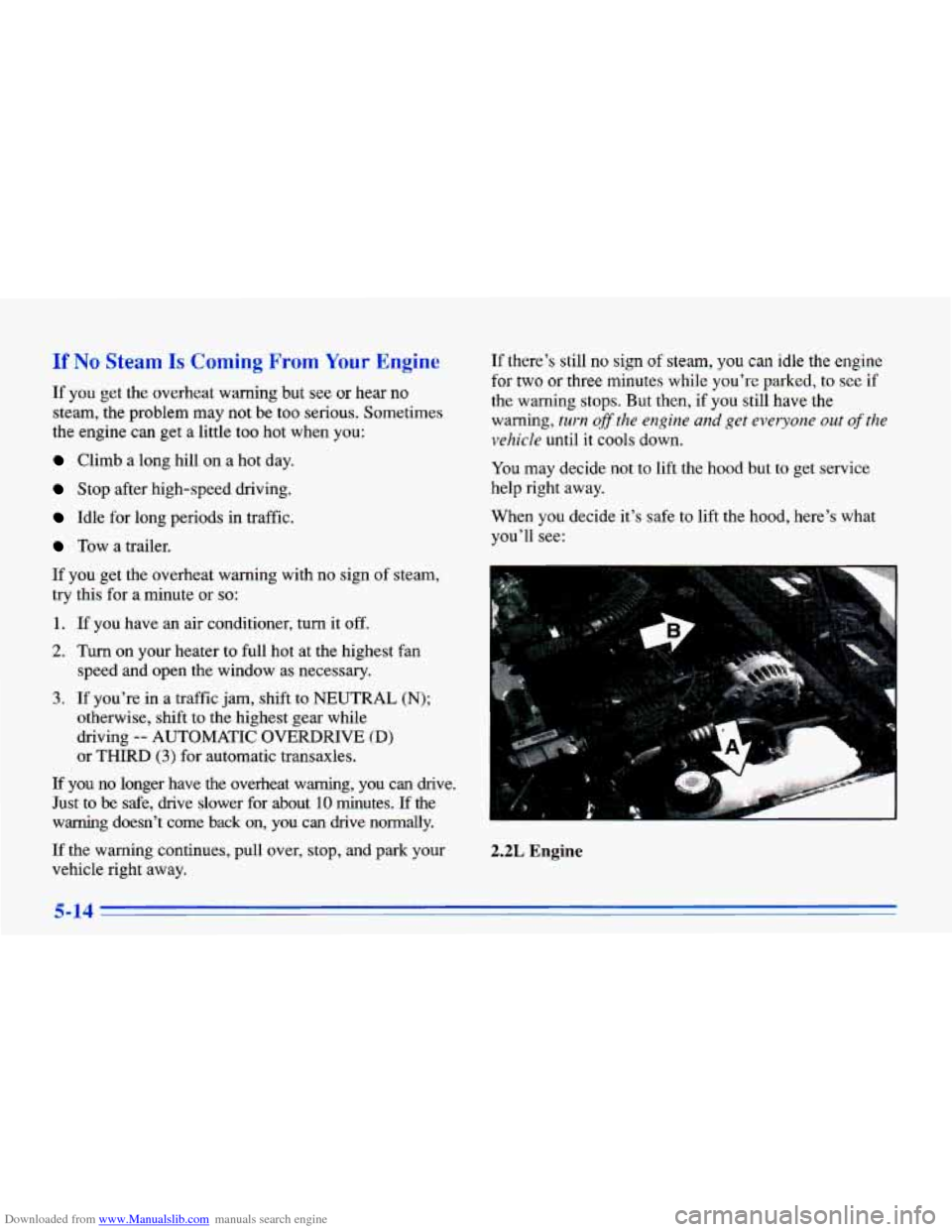
Downloaded from www.Manualslib.com manuals search engine If No Steam Is Coming From Your Engine
If you get the overheat warning but see or hear no
steam, the problem may not be too serious. Sometimes
the engine
can get a little too hot when you:
Climb a long hill on a hot day.
Stop after high-speed driving.
Idle for long periods in traffic.
Tow a trailer.
If you get the overhear warn J wlm no sign of steam,
try this for a. minute or
so:
1. If you have an air conditioner, turn it off.
2. Turn on your heater to full hot at the highest fan
speed and open the window as necessary.
3. If you’re in a traffic jam, shift to NEUTRAL (N);
otherwise, shift to the highest gear while
driving
-- AUTOMATIC OVERDRIVE (D)
or THIRD (3) for automatic transaxles.
If you no longer have the overheat warning, you can drive.
Just to be safe, drive slower for about
10 minutes. If the
warning doesn’t come back on, you can drive normally.
If the warning continues, pull over, stop,
and park your
vehicle right away.
If there’s still no slgn of steam, you can idle the engine
for two or three minutes while you’re parked, to see if
the warning stops. But then, if you still have the
warning,
turn ofthe engine and get everyone out of the
vehicle until it cools down.
You may decide not to lift the hood but to get service
help right away.
When you decide it’s safe to lift the hood, here’s what
you’ll see:
2.2L
Engine
5-14
Page 219 of 372
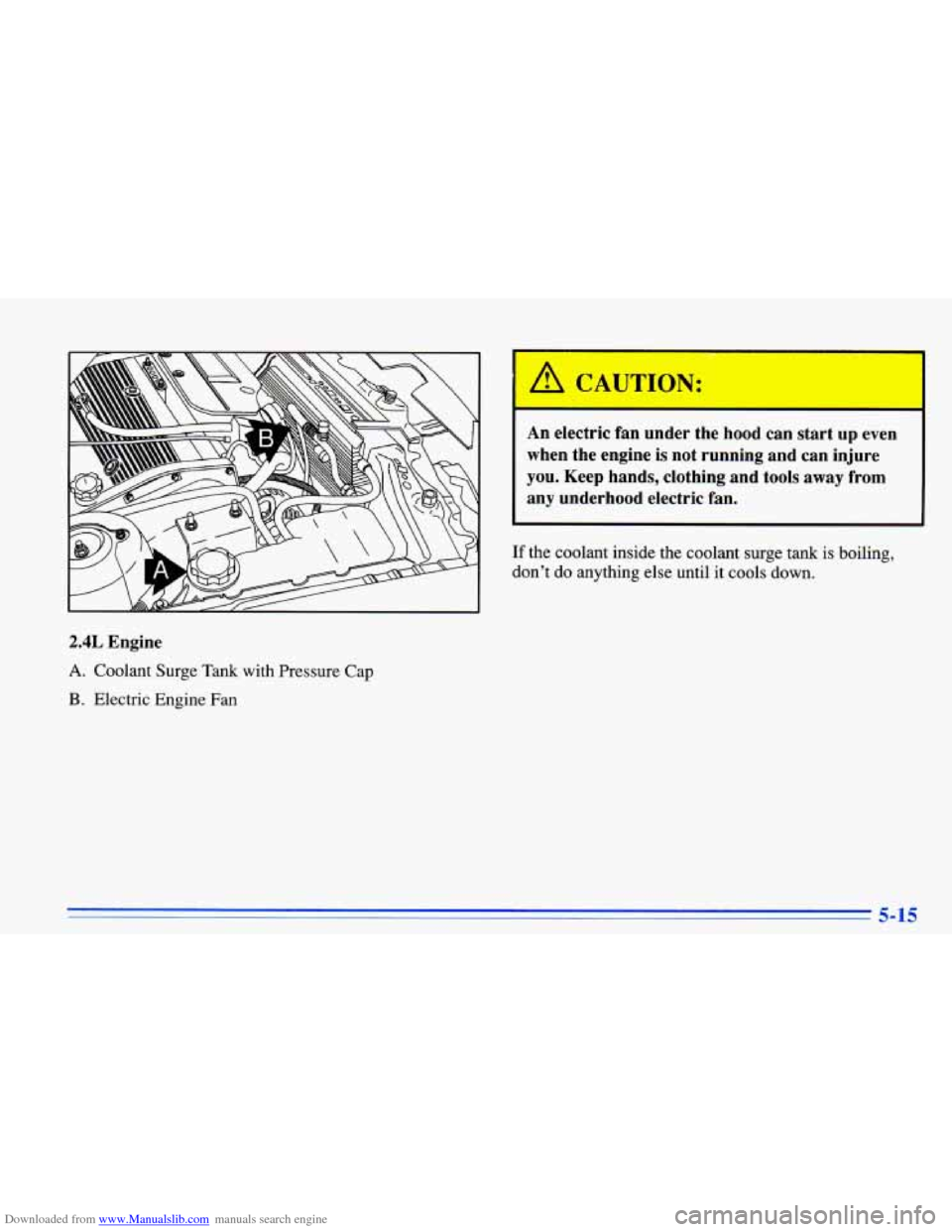
Downloaded from www.Manualslib.com manuals search engine If the coolant inside the coolant surge tank is boiling,
don't do anything else until it cools down.
2.4L Engine
A. Coolant Surge Tank with Pressure Cap
B. Electric Engine Fan
A C * "TION:
An electric fan under the hood can start up even
when the engine is not running and can injure
you. Keep hands, clothing and tools away from
any underhood electric fan.
Page 220 of 372
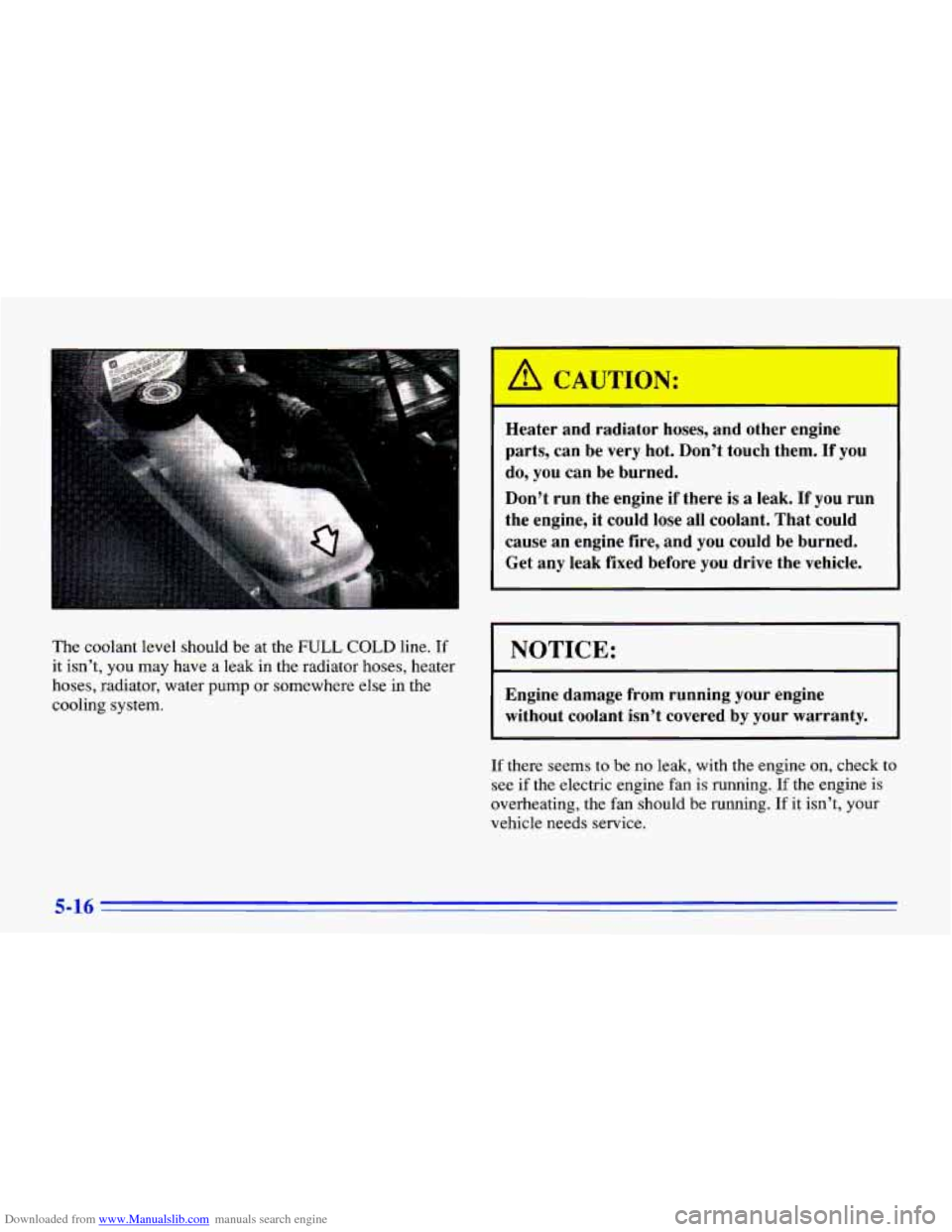
Downloaded from www.Manualslib.com manuals search engine The coolant level should be at the FULL COLD line. If
it isn’t, you may have a leak in the radiator hoses, heater
hoses, radiator, water pump
or somewhere else in the
cooling system.
’ A C * UTION:
-- I
Heater and radiator hoses, and other engine
parts, can be very hot. Don’t touch them. If you
do, you can be burned.
Don’t run the engine
if there is a leak. If you run
the engine, it could lose all coolant. That could
cause an engine fire, and you could be burned.
Get any leak fixed before you drive the vehicle.
I NOTICE:
r
~~ ~
Engine damage from running your engine
without coolant isn’t covered by your warranty.
If there seems to be no leak, with the engine on, check to
see if the electric engine fan is running.
If the engine is
overheating, the fan should be running. If it isn’t, your
vehicle needs service.